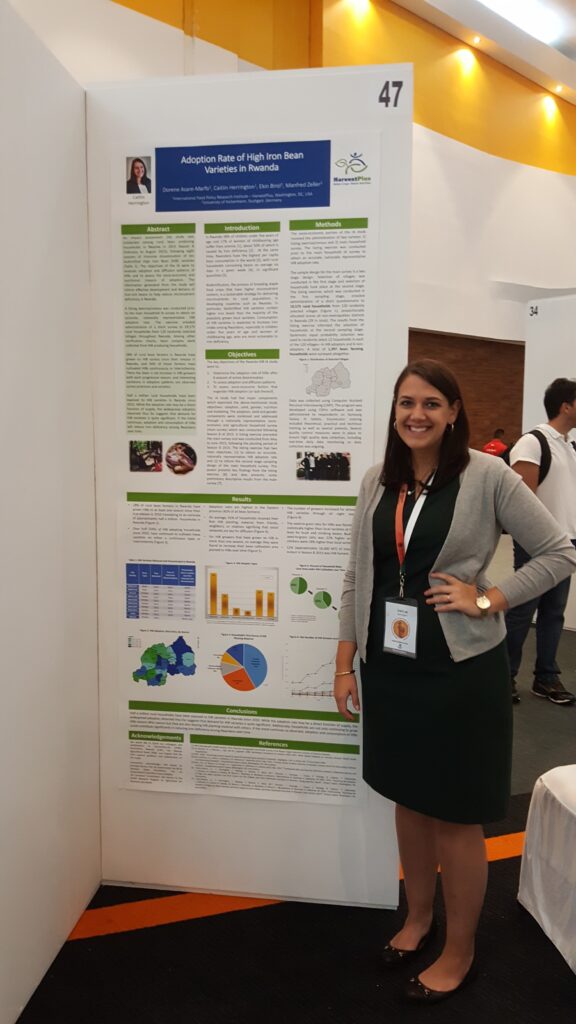“What’s the evidence?” This pivotal question is often one of the first ones asked during discussions on biofortification; researchers, donors, partners, and national governments all want to know the answer. That answer is what moves biofortification from an innovative idea to a feasible, scalable, and a life-changing intervention against micronutrient malnutrition (also known as hidden hunger) in Africa, Asia, and Latin America.
One purpose of the HarvestPlus Impact Research Unit is to answer that question. Our research addresses specific questions such as:
• Where should biofortified crops be introduced for the biggest impact?
• Do farmers like biofortified varieties of crops?
• Do consumers want to eat biofortified foods?
• What is the best way to deliver biofortified planting material to farmers?
• What is the livelihood impact?, and
• How do we disseminate information about biofortification to meet our target population audience?
The answers to these questions not only build the evidence base for biofortification, but also inform breeding and crop development, as well as delivery strategies for scaling up. In addition to channeling this research back into the HarvestPlus program and its partners to maximize impact, we also share this information at national and global conferences to showcase the great impact of biofortification and to elicit feedback from experts across various disciplines. This compels us to ensure that we continue to use cutting-edge and relevant research methodology and tools to produce results-driven evidence.
This past fall, the Impact Research Unit showcased research evidence at three major international conferences. At the 5th African Association of Agricultural Economists Conference in Addis Ababa, Ethiopia, we delivered a symposium presentation titled From Implementation to Impact: Targeting and Measuring Biofortification Interventions. This symposium highlighted the role of economics research in biofortification through targeting, testing, and measuring for impact. The discussant, David Spielman (Senior Research Fellow of the International Food Policy Research Institute) commended our efforts to conduct program-relevant research and to put evidence-based research into action in our breeding and delivery programs.
In Ghana, the Impact Research Unit represented HarvestPlus at the Regional Strategic Analysis and Knowledge Support System (ReSAKSS) with team members presenting at a biofortification-focused side event, Biofortification in Africa: Evidence of Success and Vision for Scaling Up. The session was chaired by Honorable Professor Ruth Oniang’o, Editor-in-Chief of the African Journal of Food, Agriculture, Nutrition and Development (AJFAND) and the discussion was led by Lawrence Haddad, Executive Director of the Global Alliance for Improved Nutrition (GAIN). A chapter on biofortification titled The Role of Biofortification as Part of More Diverse Diets in Africa: Progress, Challenges, and Opportunities was also included in the 2015 Annual Trends and Outlooks ReSAKSS Report, and was presented during a plenary session titled Looking Forward to Better Nutrition for Africa.
Finally, the Impact Research Unit participated at the 2016 Micronutrient Forum in Mexico where team members shared interdisciplinary work on Africa, Asia, and Latin America with nutrition audiences from around the world. Our poster presentations encompassed the adoption and consumption of biofortified crops and foods in both Africa and Latin America and the Caribbean. We also presented the Cost-Effectiveness of Biofortification: A Case Study of High Zinc Rice in Bangladesh at a side event with other members of the HarvestPlus team.
Look out for the Impact Research Unit, along with other HarvestPlus research units, at upcoming conferences and stakeholder events as we share more evidence-based research for scaling up biofortification in Africa, Asia, and Latin America.
**The author is a Senior Research Assistant with HarvestPlus
